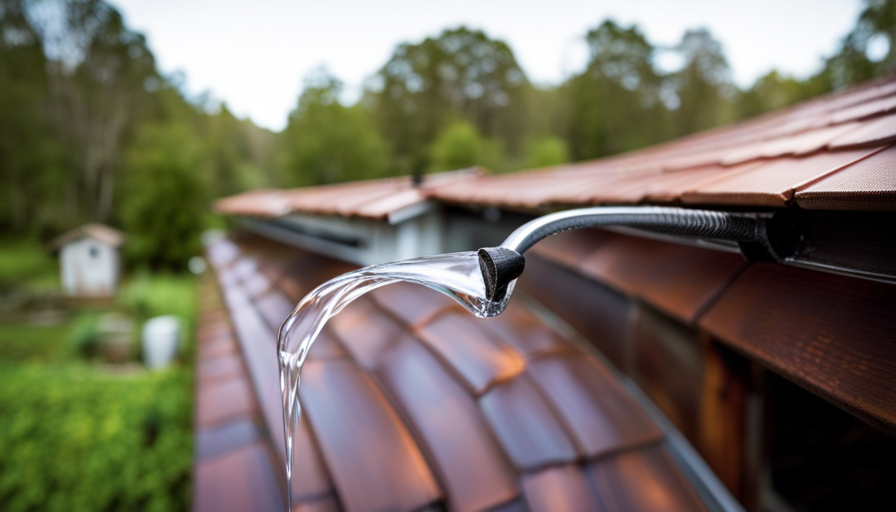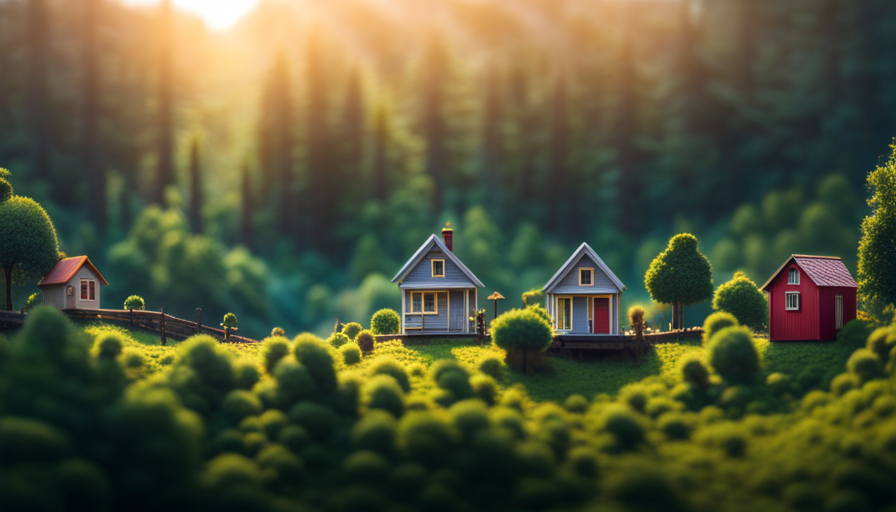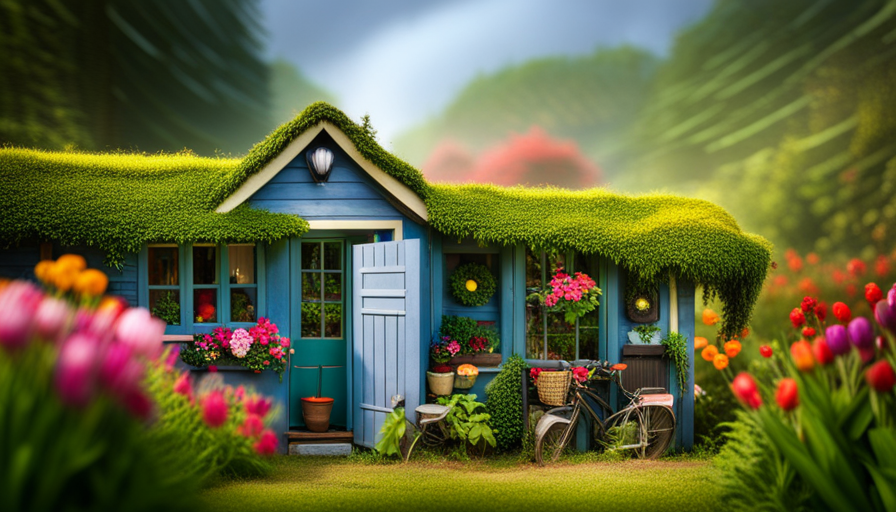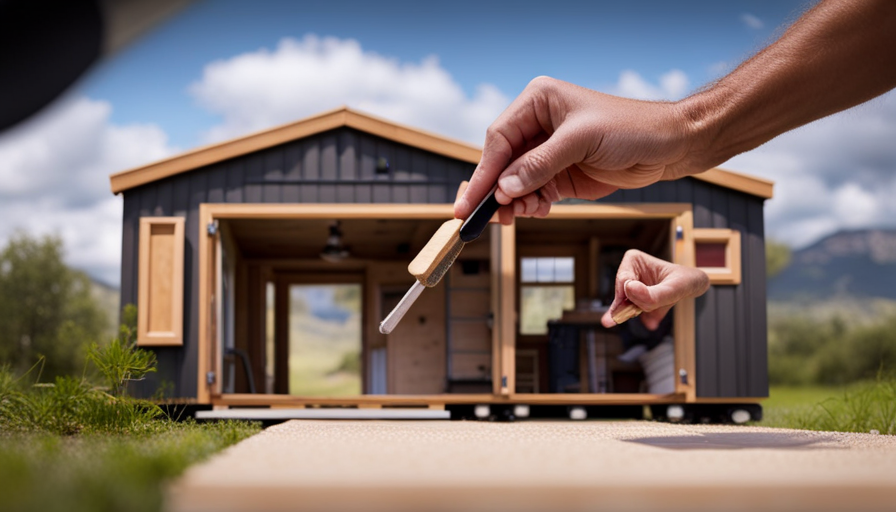Did you know that water leakage is a common issue for tiny house residents? In fact, over 90% of tiny house owners experience some form of water damage in their first year of living in their small home. As a fan of tiny houses, I understand the importance of addressing this issue head-on.
That’s why I’ve conducted extensive research and gathered expert advice on how water finds its way into these small spaces. In this article, we will explore the various sources of water infiltration, such as roof leaks, improper sealing, and plumbing issues. We will also discuss preventive measures, including exterior maintenance, ventilation systems, and proper sealing of windows and doors. Additionally, we will touch on the steps to take in case water damage and mold remediation become necessary.
So, let’s dive in and learn how to keep our tiny houses dry and cozy!
Key Takeaways
- Water infiltration is a common issue faced by tiny house owners, with over 90% experiencing water damage within the first year.
- Sources of water infiltration include roof leaks, improper sealing, and plumbing issues.
- Faulty windows and doors can allow water to seep inside.
- Damaged or improperly installed roofs can contribute to water leaks.
Understanding the Common Sources of Water Infiltration
You may be surprised by the various ways water can sneak into your tiny house, seeping through cracks and crevices like a stealthy intruder in the dead of night. Understanding the common causes of water infiltration is crucial to preventing potential damage and maintaining a dry interior.
One common cause of water infiltration is faulty windows and doors. Poor installation or worn-out seals can create gaps that allow water to seep inside. Regularly inspecting and maintaining these entry points can help prevent water intrusion.
Another common culprit is a damaged or improperly installed roof. Missing shingles, cracked flashing, or clogged gutters can all contribute to water leaks. Regular roof inspections and repairs, along with proper gutter maintenance, can mitigate these issues.
Additionally, inadequate insulation can lead to condensation and moisture buildup, creating an environment conducive to mold growth. Ensuring proper insulation installation and ventilation can help prevent this.
By understanding these common causes and implementing prevention methods such as regular inspections and maintenance, you can safeguard your tiny house from water infiltration. Assessing and maintaining the exterior of your tiny house is the next crucial step in keeping it watertight.
Assessing and Maintaining the Exterior of Your Tiny House
Step outside and take a look at how the exterior of your tiny house is holding up. Inspecting the exterior regularly is crucial for maintaining the structure and preventing water infiltration.
Here are some key areas to focus on during your inspection:
-
Roof: Check for any missing or damaged shingles, as well as signs of wear and tear. Ensure that the flashing around chimneys and vents is intact and properly sealed.
-
Siding: Look for cracks, gaps, or loose panels in the siding. These can allow water to penetrate the walls and cause damage over time.
-
Windows and doors: Examine the seals around windows and doors to ensure they’re tight and intact. Replace any cracked or broken glass and repair or replace damaged weatherstripping.
-
Gutters and downspouts: Clean out any debris from the gutters and ensure they’re securely attached. Make sure the downspouts are directing water away from the foundation of the house.
-
Foundation: Inspect the foundation for cracks or signs of water damage. Seal any cracks and ensure proper drainage away from the house.
By regularly inspecting the exterior and maintaining its integrity, you can greatly reduce the risk of water infiltration. This’ll lay the foundation for installing proper ventilation systems in the subsequent section.
Installing Proper Ventilation Systems
To ensure a well-ventilated and comfortable living space, it’s essential to install appropriate ventilation systems within your tiny house. Ventilation installation plays a crucial role in maintaining indoor air quality and preventing the accumulation of moisture, which can lead to mold and mildew growth.
There are different types of ventilation systems that can be installed in a tiny house, including mechanical ventilation systems and natural ventilation options. Mechanical ventilation systems, such as exhaust fans and air exchange units, actively remove stale air and introduce fresh air into the living space. These systems help control humidity levels and improve indoor air quality. Natural ventilation options, such as windows and vents, rely on natural air movement to promote airflow and reduce moisture buildup.
When installing ventilation systems, it’s important to consider the specific needs and layout of your tiny house. Proper placement of vents and fans is crucial to ensure effective air circulation throughout the entire space. Additionally, it’s essential to choose ventilation systems that are energy-efficient and quiet to maintain a peaceful living environment.
Installing proper ventilation systems is just one aspect of moisture control in a tiny house. The next section will discuss the importance of properly sealing windows and doors to further prevent water infiltration and maintain a comfortable living space.
Properly Sealing Windows and Doors
When it comes to maintaining a comfortable and dry living environment in your tiny house, it’s crucial to ensure that windows and doors are properly sealed to keep the elements at bay and create a cozy sanctuary where you can truly feel at home. Properly sealing windows and doors not only helps to prevent water from entering your tiny house, but it also plays a key role in preventing condensation and maintaining a desirable indoor temperature.
To effectively seal windows and doors, there are various waterproofing techniques that can be employed. One common method is to use weatherstripping, which involves applying a strip of material to the edges of windows and doors to create a tight seal. Another technique is to use caulk or sealant to fill any gaps or cracks in the window frames or door jambs. This helps to prevent water from seeping in and causing damage.
In addition to these techniques, it is important to choose windows and doors that are specifically designed for tiny houses. These products often come with built-in weatherproofing features, such as double or triple glazing and insulated frames, which further enhance their ability to keep water out and prevent condensation.
By properly sealing windows and doors, you can create a watertight barrier that not only keeps your tiny house dry, but also helps to maintain a comfortable and healthy living environment. Taking these precautions with your windows and doors is just the first step in ensuring that your tiny house remains free from water damage. In the subsequent section, we will discuss how to take similar precautions with your plumbing and water systems.
Taking Precautions with Plumbing and Water Systems
Now, let’s talk about how you can ensure that your plumbing and water systems in your tiny house are protected.
Preventing leaks and conserving water are essential aspects to consider when setting up your plumbing system in a tiny house. To prevent leaks, it’s crucial to use high-quality plumbing materials and properly install them. Invest in durable pipes and fittings that are resistant to corrosion and can withstand the challenges of a tiny house environment. It’s also important to regularly inspect your plumbing system for any signs of leaks or damage. Addressing leaks promptly can save you from costly repairs and water damage.
Water conservation is another important aspect of managing your water systems in a tiny house. Consider installing low-flow fixtures, such as faucets and showerheads, to minimize water usage. Additionally, using water-saving appliances and implementing water recycling systems, like greywater systems, can help reduce your water footprint.
By preventing leaks and conserving water, you can ensure the longevity and efficiency of your plumbing and water systems in your tiny house. In the next section, we’ll discuss how to deal with water damage and mold remediation, which are critical issues to address in case of any plumbing mishaps.
Dealing with Water Damage and Mold Remediation
When it comes to dealing with water damage and mold remediation in my tiny house, I’ve learned the importance of quickly identifying and addressing any signs of water damage. This means regularly inspecting areas prone to leaks, such as the roof, windows, and plumbing system.
If mold is found, it’s crucial to hire professionals for a thorough inspection and removal process, as mold can cause serious health issues.
Additionally, implementing preventive measures, such as proper ventilation and regular maintenance, is essential to avoid future water damage and mold growth.
Quickly Identifying and Addressing Water Damage
Addressing water damage in a tiny house is crucial as it can lead to costly repairs. An estimated 14% of tiny homeowners experience water-related issues. To quickly identify and address water damage, here are some essential steps:
-
Conduct a visual inspection of the house, looking for signs of leaks such as water stains, peeling paint, or warped surfaces.
-
Use a moisture meter to detect hidden leaks behind walls or under flooring.
-
Remove any wet materials immediately to prevent further damage and mold growth.
-
Use fans, dehumidifiers, and open windows to dry out moisture and promote ventilation.
By promptly identifying and addressing water damage, you can prevent further deterioration of your tiny house and mitigate the risk of mold growth. Hiring professionals for mold inspection and removal is the next crucial step in ensuring the long-term integrity of your tiny house.
Hiring Professionals for Mold Inspection and Removal
To ensure the long-term integrity of your tiny abode, it’s time to bring in the experts for a professional mold inspection and removal. DIY mold removal may seem like a cost-saving option, but it’s crucial to understand the risks involved.
Mold spores can easily spread during the removal process, leading to further contamination and health hazards. Hiring professionals who specialize in mold inspection and removal ensures that the job is done thoroughly and safely.
Regular inspections are also vital in preventing mold growth. Professionals have the knowledge and tools to identify hidden moisture sources and potential mold hotspots. By addressing these issues early on, you can avoid costly repairs and health problems down the line.
Implementing preventive measures to avoid future issues, such as proper ventilation and moisture control, will be discussed in the following section.
Implementing Preventive Measures to Avoid Future Issues
It’s time to take proactive steps to safeguard your tiny abode from future mold issues by implementing preventive measures.
To prevent leaks and ensure water doesn’t seep into your tiny house, here are some effective waterproofing techniques to consider:
-
Seal all exterior openings: Apply caulking or weatherstripping around windows, doors, and vents to create a watertight seal and prevent water entry.
-
Install proper ventilation: Good ventilation reduces moisture buildup, preventing mold growth. Consider installing vents or fans in areas prone to moisture, such as bathrooms and kitchens.
-
Use moisture-resistant materials: Opt for materials like moisture-resistant drywall, waterproof flooring, and mold-resistant paint to minimize water damage.
-
Maintain regular inspections: Conduct routine checks for any signs of leaks or water damage. Promptly address any issues to prevent further damage and mold growth.
By implementing these preventive measures, you can ensure a dry and mold-free environment in your tiny house.
Frequently Asked Questions
What are some common signs of water infiltration in a tiny house?
Some common signs of water infiltration in a tiny house include water stains on walls or ceilings, musty odors, mold or mildew growth, and warped or damaged wood. To prevent water damage, it’s important to follow best practices for waterproofing a tiny house. This includes properly sealing windows and doors, installing a vapor barrier, and ensuring proper drainage around the foundation. Regular inspections and maintenance can help identify and address any potential water infiltration issues.
How can I prevent water damage in my tiny house?
To prevent water damage in my tiny house, I employ various waterproofing techniques. One such technique is sealing all the openings, like windows and doors, with weatherstripping to keep water from seeping in.
I also make sure to install a high-quality roof with proper flashing to divert rainwater away from the structure.
Additionally, I use waterproof materials for the walls and floors, and regularly check for any signs of water infiltration to quickly address any potential issues.
Are there any specific types of insulation that can help prevent water infiltration?
Water resistant insulation is crucial for preventing water infiltration in a tiny house. The best insulation option in this case is closed-cell spray foam insulation. Its dense structure and impermeable nature make it highly resistant to water penetration. This insulation creates a strong barrier against moisture, preventing any potential water damage.
Additionally, closed-cell spray foam insulation has a high R-value, providing excellent thermal insulation. It’s important to ensure proper installation of this insulation to maximize its effectiveness in preventing water infiltration.
What should I do if I notice mold in my tiny house?
If I notice mold in my tiny house, there are some important steps I should take.
First, I need to address the source of moisture to prevent further mold growth. This can include fixing any leaks or improving ventilation.
Next, I should wear protective gear and use effective mold removal methods, such as scrubbing the affected areas with a bleach solution or using specialized mold cleaners.
Regularly inspecting and maintaining my tiny house can help prevent future mold issues.
Is it necessary to hire a professional for water damage and mold remediation, or can I do it myself?
Personally, I believe it’s essential to hire professionals for water damage and mold remediation.
While DIY water damage repair may seem cost-effective, it often lacks the expertise and specialized equipment necessary to effectively address the issue.
Professionals can accurately assess the extent of the damage, provide thorough cleanup and drying, and prevent further mold growth.
However, it’s important to weigh the pros and cons, including cost and the severity of the damage, before making a decision.
Conclusion
So there you have it, the ins and outs of how water can infiltrate a tiny house. It’s important to stay vigilant and take the necessary precautions to prevent water damage and mold growth.
Remember to regularly assess and maintain the exterior of your tiny house, install proper ventilation systems, and seal windows and doors effectively. And if you do encounter water damage, don’t panic. With the right knowledge and tools, you can tackle the problem head-on and ensure the longevity of your tiny house.
Stay tuned for more tips and tricks on how to make the most out of your tiny living experience.
Hi, I’m Emma. I’m the Editor in Chief of Tiny House 43, a blog all about tiny houses. While tree houses are often associated with childhood, they can be the perfect adult retreat. They offer a cozy space to relax and unwind, surrounded by nature. And since they’re typically built on stilts or raised platforms, they offer stunning views that traditional homes simply can’t match. If you’re looking for a unique and romantic getaway, a tree house tiny house might just be the perfect option.










